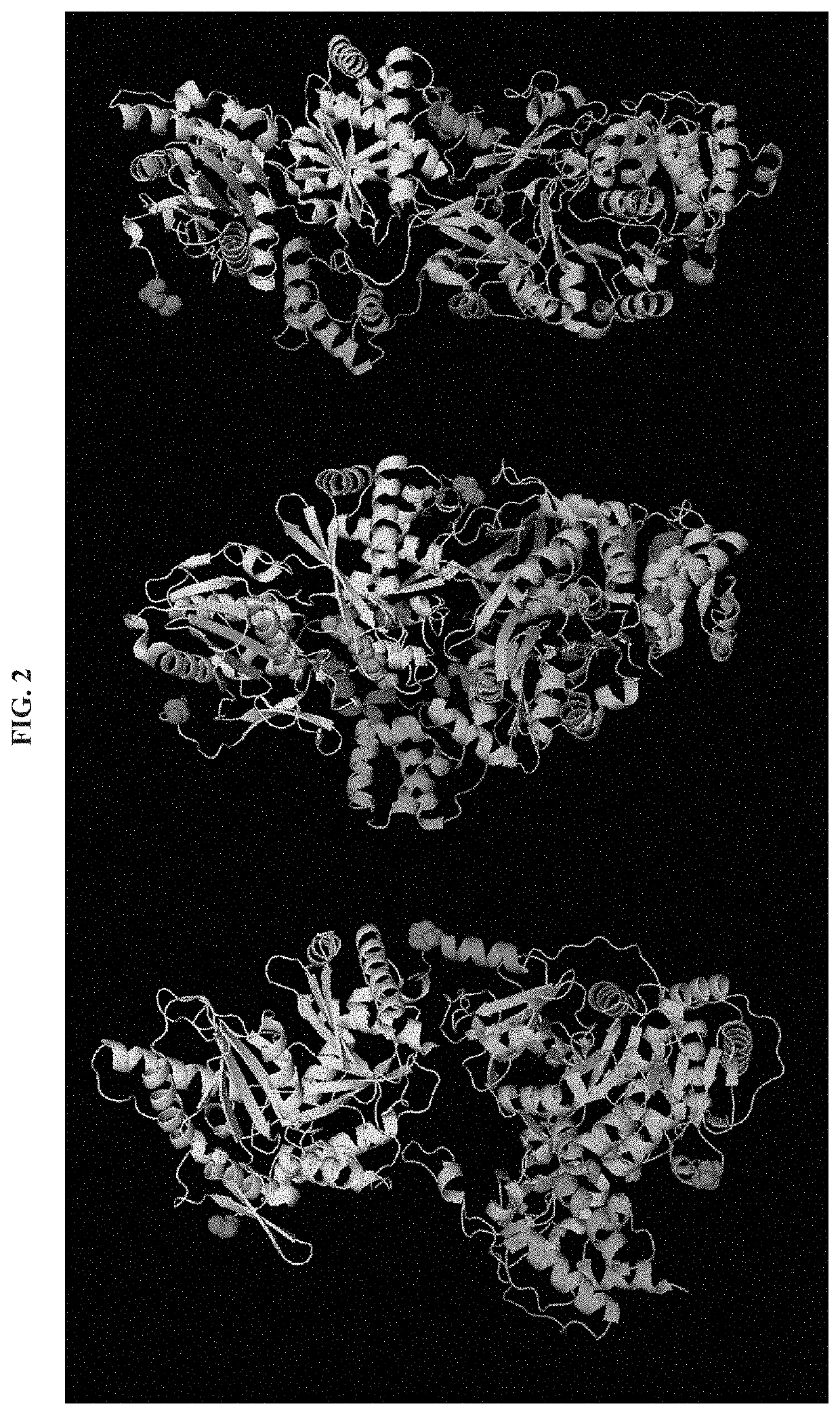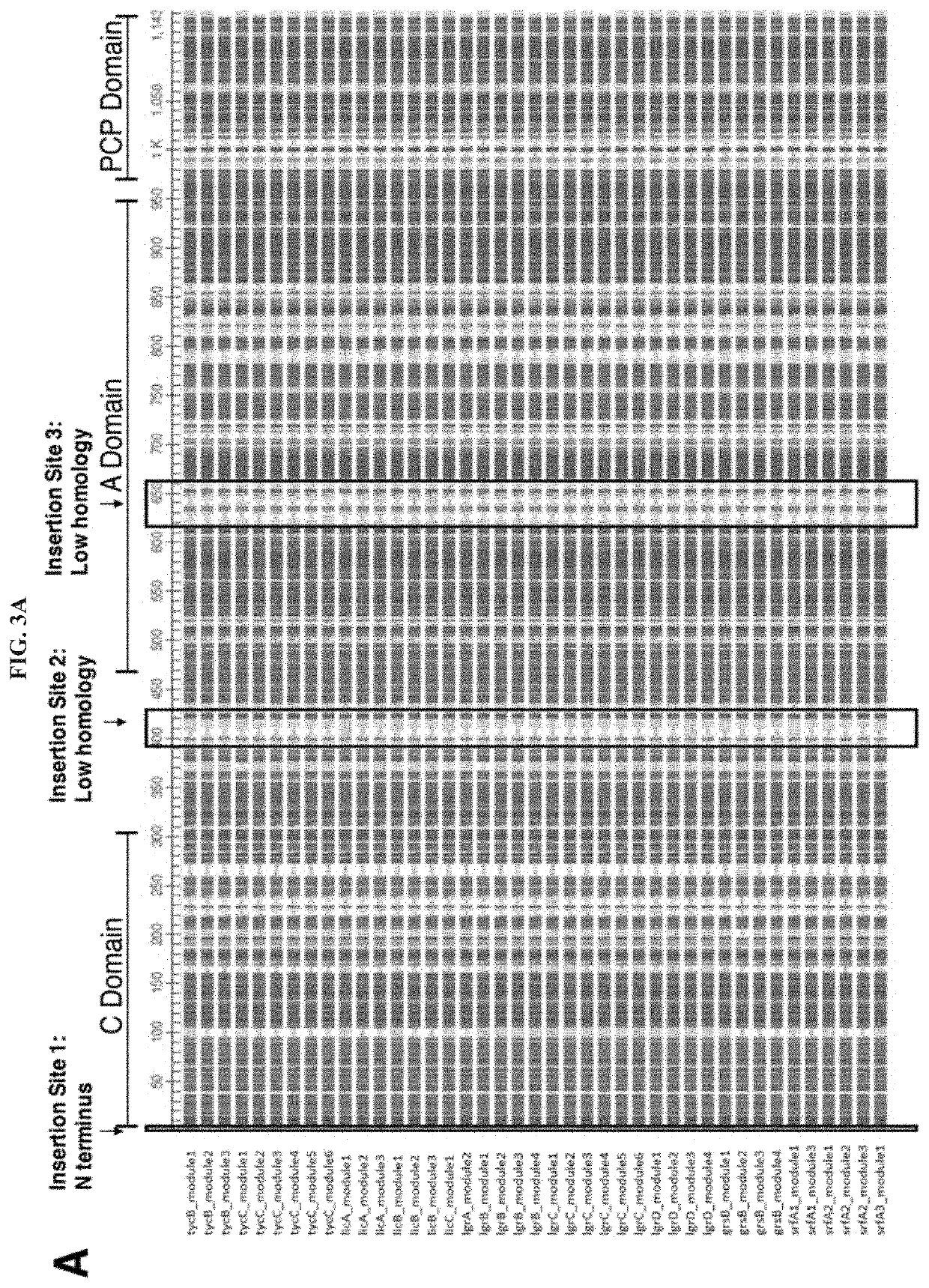Artificial Ribosomes for Fully Programmable Synthesis of Nonribosomal Peptides
a technology of nonribosomal peptides and ribosomes, which is applied in the direction of peptides, peptide sources, ligases, etc., can solve the problem of not yielding a scalable method for producing nonribosomal peptides
- Summary
- Abstract
- Description
- Claims
- Application Information
AI Technical Summary
Benefits of technology
Problems solved by technology
Method used
Image
Examples
example 1
NRPS Module Isolation and Characterization
[0075]We cloned NRPS modules from strains of bacteria having well characterized NRPS operons. We acquired the bacterial strains for biosynthesis of the nonribosomal peptides tyrocidine (Tyc), gramicidin (Lgr), surfactin (Srf), and lichenysin (Lic). A strain that synthesizes gramicidin S (Grs) will be obtained. The NRPS complexes for Tyc, Lgr, Srf, Lic, and Grs contain a total of 45 different NRPS modules responsible for the addition of individual amino acid residues to the nonribosomal peptide. A single NRPS protein can contain multiple NRPS modules. Thus, we used published sequencing data to identify the boundaries between adjacent NRPS modules and designed 45 pairs of primers to amplify each module from the genome of the bacterial source strain and insert the module into an expression vector using Gibson assembly. The PCR primers successfully amplified the NRPS modules, producing DNA products of the expected molecular weight. Expression pl...
example 2
Generating Functional NRPSs after Incorporation of RNA-Binding Peptide Domains
[0082]To generate NRPS modules that can bind to tRNA analogs, we have constructed plasmids for expressing six of the lichenysin NRPS modules (licA1, licA2, licA3, licB1, licB2, and licB3) fused to one of four potential RNA-binding peptides (LambdaN(G1N2R4), P22N, RSG1.2, and BIV-Tat). The peptides were inserted near the N-terminus of the NRPS module just after the His-purification tag based on our prior NRPS module structural analyses. Sequencing was used to confirm proper assembly of 15 of NRPS fusions and they were all tested for expression in E. coli BL21 Star DE3 using IPTG to induce transcription of the NRPS mRNA. Expression was carried out overnight at 18° C. to encourage proper fusion protein translation and folding. Uninduced controls lacking IPTG were also prepared for comparison. Following cell lysis and centrifugation to remove cell debris, the products remaining in the supernatant were characte...
example 3
Isolated NRPSs Retain Functionality after Loading onto a tRNA Analog
[0086]Gel-shift assays were performed to determine if the NRPS modules fused to RNA-binding peptides could successfully bind to their corresponding RNA aptamers. RNA transcripts bearing each aptamer were first prepared using in vitro transcription and column purified. The aptamer was then incubated with 4× excess of one of the three wild-type modules or five fusion modules for 40 minutes. The resulting products were then analyzed on 6% native PAGE RNA gels to assess the binding between RNA and enzyme.
[0087]FIG. 8 shows three sets of experiments performed using the BIV-Tat, lambdaN(G1N2R4), and P22N aptamers. For the BIV-Tat aptamer, we observed substantial interaction between the BIV-Tat-licB1 fusion and the aptamer (FIG. 8, left). In particular, the primary aptamer band, as indicated by the red arrow, nearly completely disappears upon exposure to the fusion protein since the high-molecular-weight fusion protein cap...
PUM
| Property | Measurement | Unit |
|---|---|---|
| Molar density | aaaaa | aaaaa |
| Biological properties | aaaaa | aaaaa |
| Nucleic acid sequence | aaaaa | aaaaa |
Abstract
Description
Claims
Application Information
 Login to View More
Login to View More - R&D
- Intellectual Property
- Life Sciences
- Materials
- Tech Scout
- Unparalleled Data Quality
- Higher Quality Content
- 60% Fewer Hallucinations
Browse by: Latest US Patents, China's latest patents, Technical Efficacy Thesaurus, Application Domain, Technology Topic, Popular Technical Reports.
© 2025 PatSnap. All rights reserved.Legal|Privacy policy|Modern Slavery Act Transparency Statement|Sitemap|About US| Contact US: help@patsnap.com



